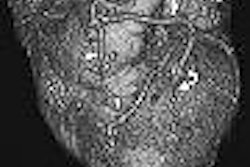Depending on where one stands in the radiation hormesis debate, a new study on CT lung screening may or may not be of concern. Still, new estimates of a 5% increase in excess lung cancers among frequently screened smokers are noteworthy in anyone's book, and may even prompt some radiologists to fine-tune their protocols.
"The potential benefits of lung cancer screening have been much discussed, as have the potential risks of invasive procedures from false-positive findings, wrote David Brenner, Ph.D., DSc, in Radiology. "Less attention has been paid to the potential radiation risks -- specifically radiation-induced lung cancer -- associated with CT lung screening. In part this is because the screening technique involves 'low-dose' rather than standard CT lung scans, and in part because excess relative risks of radiation-induced cancer generally decrease markedly with increasing age" (Radiology, May 2004, Vol. 231:2, pp. 440-445).
However, Brenner cited a number of considerations suggesting that the risk of lung screening may not be negligible. First, assessments of the interaction between radiation and smoking have shown that cancer risks are generally multiplicative of background cancer risk, which obviously applies to a screening population of smokers and former smokers. Second, radiation-associated risks do not appear to decline with age for lung cancers as they do with other forms of the disease.
Finally, the well known atomic bomb survivor data from Hiroshima are directly applicable to lung cancer cases, and in comparable doses, Brenner stated.
"For example, 10 low-dose CT lung screening examinations would produce lung doses in the range of 25 to 90 mGy," he wrote. "Among approximately 30,000 individuals in the cancer incidence cohort of atomic bomb survivors who received doses between 5 and 100 mSv (mean dose, 29 mSv), there was a statistically significant increase in cancer risk (77 excess cancers, p = 0.05) compared to that in the control population."
In his report, Brenner derived the dose-, sex-, and smoking status-dependent excess relative risks of lung cancer from cancer incidence data for atomic bomb survivors, and then calculated the excess lung cancer risks associated with a single CT lung examination at a given age in a U.S. population. From these he calculated the overall risks associated with annual CT lung screening, the goal of most current trials.
According to this calculation, the estimated lifetime excess relative risk for a 50-year-old female smoker who receives a typical 5.2 mGy dose in CT lung screening is 0.0037. The estimated age-shifted background lifetime lung-cancer risk is 0.16, the estimated probability of surviving at least 10 years is 0.96, and thus, the estimated excess lung cancer risk due to the single CT exam is 0.00057.
However, were the same 50-year-old woman to continue annual screening through age 75, she would accrue an estimated excess lung cancer risk of 0.85% (95% CI: 0.28%, 2.2%) associated with the total radiation exposure, not including the expected lung cancer risk of 16.9%. For a 50-year-old male smoker, the accumulated excess risk is 0.23% (95% CI: 0.6%. 0.63%), not including an expected lung cancer risk of 15.8%.
"If the entire U.S. population of current and former smokers aged 50-75 years -- approximately 36 million people -- were offered annual CT lung screening until age 75, with a 50% compliance rate, the estimated number of lung cancers associated with the radiation from these examinations would be about 36,000 (95% CI: 11,300, 93,600)," the author wrote. "Of the approximately 18 million people older than 50 years who would undergo annual screening until age 75, about 1.9 million would be expected to contract lung cancer independent of the CT lung radiation dose; thus, the radiation exposure from annual CT lung examinations would increase this number by approximately 1.8% (95% CI: 0.5%, 5.5%)."
The estimate drops from 36,000 to 6,000 cancers if screening starts at age 60 rather than 50, an increase in incidence of approximately 0.8%.
The author also explained why he estimated radiation risks for radiation-induced lung cancer incidence rather than mortality. Given the high mortality-to-morbidity associated with lung cancer, he wrote, incidence risks seemed reasonable.
"Given the estimated upper limit of a 5.5% increase in lung cancer risk due to annual CT-related radiation exposure, a mortality benefit of considerably more than 5% may be necessary to outweigh the potential radiation risks," he wrote. "If the radiation risks prove to be a concern, an increase in the minimum age at which screening is recommended, from 50 to 60 years, would reduce the risks considerably. Another alternative would be to screen every two years, which would reduce the radiation risk by about 50%."
By Eric BarnesAuntMinnie.com staff writer
June 14, 2004
Related Reading
Utility of CT screening for lung cancer remains unproven, June 1, 2004
CAD gets role in new ELCAP lung study, April 29, 2004
Radiologists offer new guidance on reducing CT radiation dose, August 14, 2003
Radiation doses in Hiroshima survivors confirmed, July 31, 2003
Radiation hormesis and the radiologic imperative, March 21, 2003
Studies cast doubt on low-level radiation dangers, January 30, 2003
Copyright © 2004 AuntMinnie.com



















